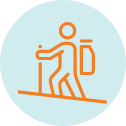
Moderately Challenging Tanzania
Our LHO Mount Meru Expedition is beyond a mere trek to the summit of a stunning stratovolcano. This trail uniquely integrates a trekking safari amidst the wild animals of nearby national parks settled on these hills. Spotting giraffes, wildebeest, warthogs, and even elephants is a unique part of this experience. Combined with our 100% safety record, LHO-trained expedition chefs, and the close collaboration between our LHO Team Leader who looks after you and our knowledgeable, vetted local lead guides, it creates an unparalleled trekking adventure experience.

TRIP TYPE
Trekking, Summit

DURATION
6 Days

DESTINATION
Tanzania
1
Led by our expert LHO Team Leaders with years of high-altitude experience.
2
Meals are carefully curated and deliciously prepared by our LHO-trained Chef.
3
100% safety record on all our altitude expeditions.






WHAT'S INCLUDED IN THIS TRIP
WHAT'S NOT INCLUDED IN THIS TRIP
DAY 1: JAMBO MOUT MERU!
Upon your arrival at Kilimanjaro International Airport, you’ll be met by a member of the LHO team who will personally pick you up and transfer you in our private shuttle to the hotel. Your LHO Team Leader will be at the hotel to greet you. Once you’ve settled in, your gear will be checked to ensure you have everything you need.
If you arrive early, you can explore the lively town of Moshi, situated between the base of Kilimanjaro and Mount Meru. For coffee and pie enthusiasts, we recommend the Union Coffee Shop in town. Your LHO Team Leader will send you a message with more recommendations of things to do closer to your trip date.
On your first night, we’ll gather for a team briefing and dinner at a trendy Moshi restaurant. Sometimes our dinners are hosted at our hotel if we feel that it would give everyone more time to prepare their belongings and get enough rest for the adventure ahead of us. This will be your first chance to meet fellow participants and your lead local guides. It’s also an opportunity to learn about the exciting experience we’ve prepared for you and ask any questions you may have.
DAY 2: GIRAFFES, WARTHOGS & WATERING HOLES
Distance: 6.3 KM | Ascent: 921 m | Descent: 13 m | Max Altitude: 2,500 m
Our first day together begins with an early ride to the Momella gate of Mount Meru. After breakfast, we’ll check out of our hotel and load up our private shuttle with our duffle bags and backpacks. Those of us who have luggage that won’t be needed for the climb will be able to leave our luggage with our valley team, who will transport them to the hotel we’ll be staying at when we return from the mountain. We use a different hotel that is closer in proximity to both the gate and the airport to shorten the distance of our post-trek shower, and departing airport transfers, and also gives us an opportunity to explore Arusha, another vibrant town in the region.
The ride to Momella gate takes about two hours, with beautiful views of both Kilimanjaro and Meru accompanying us for most of the journey. The final stretch to the gate is a bit bumpy as we join the unpaved safari roads. As we enter the jungle, the unique character of Meru starts to become apparent as the families of baboons and other monkeys start to line the sides of the street.
Once at the gate, we’ll begin check-in procedures. There isn’t much for us to do, as this is primarily a bureaucratic procedure that the team takes care of. We’ll be served a hot lunch at the gate before we begin our walk to the first Miriakamaba hut (2,500 M). Once we get the all-clear, we’ll throw our packs on and grab our poles to begin the walk. The first section of the trail is arguably the most spectacular for those of us here to spot big animals. After crossing a bridge that links the road to the Meru trail, we’ll enter a massive clearing with a stream passing through it. The stream is attractive to the many wildebeests, warthogs, and springboks that drink from its fresh spring waters. We will be accompanied by an armed park ranger for these early sections because of the danger these animals may inadvertently cause. As we approach the tree line, it is very common to find giraffes eating the high branches. We’ll be particularly careful when turning around corners, as we may startle unsuspecting animals.
From the tree line, the trail begins to climb gradually. The more we climb, the further away the larger animals become. Altitude is just not their thing. The same can’t be said for the monkeys that tend to continue to inhabit the trees inside the dense forest all the way to the hut. During the first leg of the ascent, your LHO Team Leader will have the opportunity to help you set a steady and sustainable pace that allows us to enjoy our surroundings and also move comfortably into higher altitude. The trail doesn’t get much steeper than what we experienced from the start of the incline. It remains gradual as we pass through a series of dense forests interrupted by clearings. The final path to the camp follows two switchbacks inside the forest that top out into an opening where the hut is situated. For many of us, this may be our first time ever in mountain lodges. Not to worry! We’ll give everyone a brief induction about lodge etiquette, where the bathrooms are, where to find things like tea and coffee or hot water for washing up, and what’s the best in-lodge strategy to maximize sleeping comfort. Dinner will be in the mess hall of our hut, where we’ll debrief on the day’s events and highlight some things we may need to do differently as we ascend into the higher environment over the following days. We’ll also receive a detailed briefing on what to expect for our second day on the trail.
DAY 3: THE SADDLE
Distance: 4.4 KM | Ascent: 1,090 m | Descent: 14 m | Max Altitude: 3,500 m
Our second day on the mountain starts after breakfast with an incredible change in scenery as we depart the rainforests of the mountain base and enter the alpine vegetation region. Our first morning on the mountain can sometimes feel a little overwhelming as we pack up, have breakfast, perform individual health checks, and head out for the first time. You’ll get the hang of it faster than you think, and your LHO Team Leader will be around to help you throughout.
The trail begins with a sustained ascent directly out of the hut along the eastern slopes of Mount Meru. The towering trees will continue to line the trail for the early sections of the path as the trail follows a series of wide switchbacks that take us higher and higher into altitude. After about two hours, we will notice that the thickness of the forest starts to rapidly recede, opening up the expansive views of Mount Kilimanjaro on the horizon. The types of trees will also start to change. The flowery lush rainforest fauna will be replaced by thorny pines that characterize the alpine regions of this mountain.
Lunch on this day is a picnic at a clearing near the midway point. Once we fully exit the rainforest, the trail begins to narrow, with short pine trees flanking the trail on either side. Here, the path switches back regularly as it climbs along the steeper sloping hills in this area. The switchbacks enable us to walk gradually up along the slope. If the trail were more direct, it would be much steeper and therefore much more physical. The switchbacks continue until we reach Saddle Hut (3,500 M), our home for the evening.
Once we check-in and take a rest, we’ll regroup at the mess tent for our dinner and summit briefing! Dinner is usually quite early to give us a chance to sleep as much as we can before our early start to the top on the next day. Your LHO Team Leader will be on hand to check your backpacks and make sure that we pack exactly what we need for the push to the top.
DAY 4: SOCIALIST PEAK 4,562 M
Distance: 12.2 KM | Ascent: 1,125 m | Descent: 1,125 m | Max Altitude: 4,562 m
We usually set the wakeup call at or close to midnight. However, your LHO Team Leader and local lead guide will let you know exactly what time it’ll be based on weather conditions and the general pace of the group. After a light breakfast, we’ll begin to make our way out of the hut. There is no need to pack up our rooms before heading out since we’ll be coming back here later in the day. We always recommend placing a few sugary snacks in the pockets so that they can be easily accessed for energy whenever needed. Your LHO Team Leader will be sure to reinforce this point during the briefing.
The trail out of the hut begins in a westbound direction. At first, the trail is quite flat before slowly starting to climb in a fashion similar to the trail reaching Saddle Hut. As we start to ascend the switchback, the trees will start to disappear altogether, with the final trees completely left behind just as we approach Rhino Point. This is the first summit of the trail and where we can see the summit directly in front of us, albeit across the other side of the semi-circular crater ridge that we have to continue walking along.
From Rhino Point, the ridge becomes a series of short descents followed by challenging ascents. Each ascent can feel like its summit. The difficulty here is mainly with believing that each ascent leads directly to the top only to find that it’s another false summit. It is important to keep morale high. Your LHO Team Leader will be there to support you as we push through. The sun typically starts to rise midway along the summit ridge over the silhouette of Kilimanjaro on the horizon. The sunrise is nothing short of spectacular and always brings with it renewed energy and confidence.
The last ascent begins along the outside edge of the western slopes. This is the first section of the trail moving east to west where we’re sheltered from the view of Kilimanjaro. It’s the only real indication that this is indeed the last ascent to the summit. The last steps are between gigantic boulders before the famous summit sign suddenly appears as if out of nowhere. Once at the top, we’ll take our pictures, have a quick bite, and enjoy the views. It is important to be aware that the summit is quite narrow and there are parts that are exposed to the cliffs of the east face. Please listen to your LHO Team Leader and local lead guide about the areas to avoid when taking pictures. Once done, we begin our descent back to Saddle Camp. Unlike the ascending portion of the climb, as we descend, we start feeling better and regaining our energy due to the loss of altitude. This means that those of us feeling better and moving at a pace can go down at a pace suitable for them with a guide or assistant guide. Those of us moving at a more moderate pace can take our time descending with the team and not feel pressured to keep up. A member of the LHO Team will always be the last person to reach Saddle Camp. Once we return to the camp, we will have a rest, eat lunch, pack our stuff, and then depart once more all the way back to Miriakamba Hut. It may seem like a distance, but the night’s rest and the recovery we feel back in the rainforest are well worth the push down the mountain. We’ll have dinner at the hut where our last briefing of the trip will be given.
DAY 5: MONKEYS & MORE
Distance: 10.7 KM | Ascent: 13 m | Descent: 1,996 m | Max Altitude: 3,500 m
Our last day on the mountain will be a direct descent to the Momella gate. After breakfast, we’ll descend the trail deeper into the rainforest. The familiar sight of monkeys will slowly start to ruffle the tree branches as we pass between open spaces and deep forests. We will once again be joined by an armed park ranger for this portion of the trail as we approach the clearing at the base of the mountain. It’s highly likely to see wildebeests and giraffes as well as warthogs and other animals of the region as we begin to cross the clearing past the streams and watering holes and finally to the bridge that connects us to the park gate and the end of our incredible trekking adventure.
The checkout procedures can often take a little bit of time. We’ll be met by our valley team at the gate who will have a hot lunch prepared for us as the gate formalities are being wrapped up. Once done, we’ll hop into our shuttle for a relatively short ride to our hotel in Arusha. Unlike Moshi, Arusha is a much bigger city and one of the economic hubs of the country. This town gives us the opportunity to explore bigger city life in the region and contrast that with the village atmosphere of Moshi. Your LHO Team Leader will ensure that the check-in to our hotel goes as quickly as possible so you can get to that well-deserved shower. We’ll also let you know what time we’ll be meeting up for our farewell dinner. The last round of drinks is on us!
DAY 6: HAKUNA MATATA RAFIKI!
The final day is dedicated to airport transfers. Breakfast is included at our hotel. Team members will be shuttled to the airport depending on flight times. Please be sure to communicate the correct flight times when you fill out your Team Details Form prior to this experience. Please make sure to communicate any changes to your LHO Team Leader as early as possible to ensure that arrangements are made.

OUR COMMITMENT
We are dedicated to ensuring that everyone involved in our services receives a fair living wage in their respective countries. We invest in our team members, fostering upward mobility within the adventure travel industry, expanding educational opportunities, and offering support wherever we can. By joining an LHO adventure you are directly impacting the incredible people and the remote communities that make these life-changing experiences possible.
LEARN MOREHEALTH & SAFETY GUIDELINES
We do our best to ensure your wellbeing on LHO adventures. That's why the facilities we use throughout our trips are required to meet our health and safety standards. We also follow the laws and protocols of every country that hosts our adventures. This extends to national regulations requiring Covid-19 testing, vaccination certificates, mask wearing or any other local guidelines that may apply. Contact us for the most up to date protocols related to your destination.
LEARN MOREAre there any vaccines or medications I need to take for Tanzania?
Vaccines: As a general recommendation for travel, make sure that your tetanus & hepatitis shots are up to date. If you live, are transiting through or have previously visited any country in sub-Saharan Africa in the past 5 years, you will be required to have a yellow fever vaccine and carry the booklet as proof of vaccination.
Medications: We recommend taking over the counter Malaria medication. Please consult your doctor for the tablets that work best for you.
What's the toilet situation?
There are fixed toilets at the mountain huts and at different points on the trail. The toilets are relatively well maintained. We don’t advise anyone to poop in nature because we want to preserve the environment, especially in the higher altitude locations where poop doesn’t disappear with rain, nor gets absorbed by the soil. It freezes and stays there!
Where does the drinking water come from?
Is there a need to get a purifier for drinking or tablets that purify the water?”
Drinking water is sourced from local springs on the mountain then boiled and sanitized with special tablets to ensure it’s safe to drink. You will have unlimited treated water refills throughout the expedition.
What's the temperature and weather like?
The lowest temperatures experienced on Meru are during the summit night when it can go as low as -10 Celsius. The coldest portion of the entire trip is usually the first hour of summit night and just before sunrise at around 4:30 am. On most other days temperatures can reach up to 20 degrees Celsius or higher if there’s no wind. On most nights temperatures can dip to 0 degrees Celsius.
There’s no way to climb Meru and not experience all the seasons at some point. Even during the dry season, it will still rain in the rainforest because of humidity clouds that form at the base of the mountain and get pushed up to higher altitude by midday. We’ll also feel warmer weather and may even find ourselves in shorts and t-shirts as high up as summit base camp (4,000m). Your gear list has everything you need in order to make sure you’re able to go through all the different weather conditions and enjoy every aspect of this beautiful mountain.
PAYMENT PLANS AVAILABLE
FROM £2,200
INQUIRE NOW
This adventure is only available as a private trip and is customized to your requirements, experience and skill level. To get started, please fill out the form below. We’ll be in touch soon to put it together for you.
"(Required)" indicates required fields
CONTACT US
We’re passionate about guiding you to epic adventures and beyond. If you have any questions at all, don’t hesitate to reach out. We’d love to hear from you.

